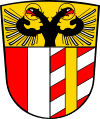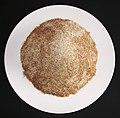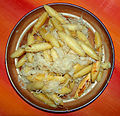Swabia Schwaben | |
|---|---|
 Map of Bavaria highlighting Swabia | |
| Country | Germany |
| State | Bavaria |
| Region seat | Augsburg |
| Area | |
| • Total | 9,993.97 km2 (3,858.69 sq mi) |
| Population (31 December 2019)[1] | |
| • Total | 1,899,442 |
| • Density | 190/km2 (490/sq mi) |
| Website | Schwaben |
Swabia (German: Schwaben, Bavarian: Schwobm) is one of the seven administrative regions of Bavaria, Germany.
Governance
The county of Swabia is located in southwest Bavaria. It was annexed by Bavaria in 1803, is part of the historic region of Swabia and was formerly ruled by dukes of the Hohenstaufen dynasty. During the Nazi period, the area was separated from the rest of Bavaria to become the Gau Swabia. It was re-incorporated into Bavaria after the war.
The Regierungsbezirk is subdivided into 3 regions (Planungsregionen): Allgäu, Augsburg, and Donau-Iller. Donau-Iller also includes two districts and one city of Baden-Württemberg.
| Landkreise (rural districts) | Kreisfreie Städte (district-free towns) | Natural regions |
|---|---|---|
|
|
* Part of the Swabian Keuper Land
Districts and district-free towns before the regional reorganization in 1972
| Kreisfreie Städte (district-free towns) | Landkreise (districts) | Landkreise (districts) (continuation) |
|---|---|---|
Population
Historical population of Swabia:
- 1939: 934,311
- 1950: 1,293,734
- 1961: 1,340,217
- 1970: 1,467,454
- 1987: 1,546,504
- 2002: 1,776,465
- 2005: 1,788,919
- 2006: 1,786,764
- 2008: 1,787,995
- 2010: 1,785,875
- 2015: 1,846,020
- 2019: 1,899,442
Economy
The Gross domestic product (GDP) of the region was € 74.8 billion in 2018, accounting for 2.2% of German economic output. GDP per capita adjusted for purchasing power was € 36,500 or 121% of the EU27 average in the same year. The GDP per employee was 101% of the EU average.[2]
History
The Bavarian administrative region of Swabia is the eastern part of the duchy of Swabia. After the execution of the Swabian duke Conradin in Naples in 1268, his uncle, the Bavarian duke Louis inherited some of Conradin's possessions in Swabia. In 1803, with the German Mediatisation, Bavaria acquired the further East Swabian territories, which were merged with Palatinate-Neuburg.
After the founding of the Kingdom of Bavaria, the state was totally reorganised and, in 1808, divided into 15 administrative districts (German: Regierungsbezirke), in Bavaria called Kreise. They were created in the fashion of the French departements, quite even in size and population, and named after their main rivers.
In the following years, due to territorial changes (e. g. loss of Tyrol, addition of the Palatinate), the number of districts was reduced to 8. The Swabian territories were merged with Palatinate-Neuburg and the new district was called Oberdonaukreis (Upper Danube District). In 1837, king Ludwig I of Bavaria renamed all the districts after historical territorial names and tribes of the area. This also involved some border changes or territorial swaps. Thus the name Oberdonaukreis changed to Swabia. In 1945, the town of Lindau was divested by France, but reunited with the district of Swabia in 1955. In 1972, the former Swabian city Neuburg an der Donau was reunited with the district of Upper Bavaria.
Main sites

Next to the capital Augsburg and several other old cities including Donauwörth, Nördlingen, Memmingen, Mindelheim, Kaufbeuren and Kempten, the Ottobeuren Abbey and the scenic attractions of the River Danube in the north and the Allgäu in the south with the Allgäu Alps and Oberstdorf and the royal castles of Hohenschwangau and Neuschwanstein next to Füssen belong to the major attractions. With the district of Lindau, Bavarian Swabia has access to Lake Constance.
Food and drink
Swabian cuisine is down-to-earth and rather simple. Noodle products are very important.
Notable people
- Michael Bredl (1916–1999), a singer and collector of traditional Swabian Volksmusik
- Ludwig Aurbacher (1784–1847), famous for his stories about The Seven Swabians
- Ludwig Ganghofer (1855-1920), writer and inventor
- Sebastian Kneipp (1821-1897), inventor of Kneipp-Kur known as Water-Doctor of Hydrotherapy
See also
- Swabian Keuper-Lias Plains
References
- ^ "Tabellenblatt "Daten 2", Statistischer Bericht A1200C 202041 Einwohnerzahlen der Gemeinden, Kreise und Regierungsbezirke". Bayerisches Landesamt für Statistik und Datenverarbeitung (in German). July 2020.
- ^ "Regional GDP per capita ranged from 30% to 263% of the EU average in 2018". Eurostat.
External links






